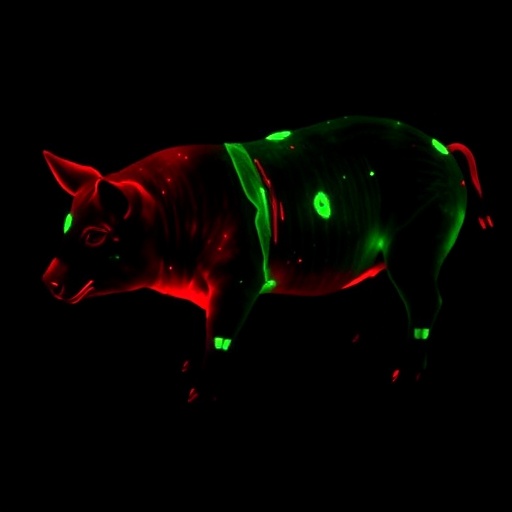In a groundbreaking development that promises to accelerate antiviral drug discovery, researchers have unveiled a novel approach to engineering infectious clones of the Porcine Reproductive and Respiratory Syndrome Virus (PRRSV) embedded with Green Fluorescent Protein (GFP). This cutting-edge work, spearheaded by Zhang, Qian, Kunec, and colleagues, harnesses the power of transformation-associated recombination (TAR) cloning technology to create robust, traceable viral constructs. These GFP-expressing infectious clones represent a significant stride forward in virology, offering unprecedented opportunities for high-throughput screening and precise antiviral efficacy assessments.
Porcine Reproductive and Respiratory Syndrome Virus stands as one of the most economically devastating pathogens in swine production worldwide, causing significant reproductive failures and respiratory illness. Despite extensive efforts, effective control measures and therapeutic options remain limited, partly due to the virus’s high mutation rate and complex biology. Creating infectious clones that express fluorescent markers enables researchers to monitor viral replication and spread in real-time, greatly enhancing the capacity to identify and characterize potential antiviral compounds.
The method employed, transformation-associated recombination cloning, is a sophisticated yeast-based cloning strategy that circumvents many limitations posed by traditional bacterial-based cloning systems. TAR cloning exploits the recombination machinery native to Saccharomyces cerevisiae, allowing the precise assembly of large viral genomes directly from overlapping DNA fragments. This approach facilitates the efficient construction of full-length infectious viral clones, while also enabling site-specific modifications—such as the insertion of the GFP gene—without compromising viral infectivity.
By integrating GFP into the PRRSV genome, the researchers have furnished a vital tool for visualizing infection dynamics. The fluorescent signal provides a direct readout of viral replication, which is invaluable in evaluating the antiviral potential of candidate compounds. This fluorescence-based assay system dramatically reduces reliance on conventional, labor-intensive methods such as plaque assays or quantitative PCR, streamlining the antiviral drug screening pipeline.
The application of TAR cloning in constructing PRRSV infectious clones marks a methodological advancement beyond prior strategies. Earlier attempts faced challenges related to genome instability, low cloning efficiency, and difficulty maintaining large RNA viral genomes in bacterial hosts. TAR cloning, by contrast, offers enhanced stability and fidelity in assembling the PRRSV genome, preserving critical viral elements necessary for replication. Such technical optimizations are crucial for generating infectious clones that accurately mimic wild-type viral behavior.
Moreover, the GFP integration strategy was meticulously designed to maintain the functional integrity of viral proteins and replication signals. The researchers targeted non-essential genomic regions for GFP insertion, ensuring that the fluorescent marker does not impair virus assembly or infectivity. This careful balancing of genetic modification and viral viability underpins the utility of these infectious clones in biological assays and drug evaluations.
In practical terms, the availability of GFP-expressing PRRSV clones enables live-cell imaging of infection processes at a single-cell level. This capability enriches our understanding of viral entry, replication, and cell-to-cell transmission mechanisms. Such insights are pivotal not only for antiviral drug development but also for vaccine design and basic viral pathogenesis research.
The implications extend to high-throughput screening platforms, where thousands of chemical entities can be tested rapidly for their ability to inhibit PRRSV replication. The fluorescent readout simplifies data acquisition and processing, enhancing sensitivity and reproducibility. Pharmaceutical research efforts targeting PRRSV can thus be invigorated with this novel tool, potentially expediting the path to effective therapeutics.
Beyond drug discovery, these infectious clones offer a versatile platform for studying viral genetics and evolution. Researchers can introduce site-specific mutations or chimeric sequences to dissect viral determinants of virulence, immune evasion, and host specificity. GFP fluorescence serves as an intrinsic reporter, facilitating phenotypic analyses of mutant viruses without necessitating additional labeling procedures.
The study also highlights the broader applicability of TAR cloning to other RNA viruses with complex genomes, suggesting a generalizable approach for virologists grappling with challenging cloning projects. By demonstrating the robust production of infectious GFP-expressing clones in PRRSV, the authors set a precedent for similar strategies in related pathogens, potentially impacting multiple facets of viral research.
Critically, the integration of GFP does not significantly alter the viral replication kinetics or pathogenic potential, as confirmed by comparative analyses against wild-type viruses. This validation ensures the biological relevance of experimental findings derived from GFP-expressing clones, bolstering confidence in data interpretation.
From a technical perspective, the successful assembly of PRRSV genomes exceeding 15 kilobases underscores the efficacy of TAR cloning in managing large, unstable viral sequences. The method’s efficiency reduces the time and resources traditionally required for infectious clone generation, accelerating the research workflow.
Furthermore, the refined molecular tools presented in this study equip laboratories with the capacity to perform real-time antiviral assays under biosafety conditions reflective of natural infection. The fluorescent clones bridge the gap between molecular virology and applied therapeutics, translating genetic engineering advances into practical benefits.
In summary, the development of GFP-expressing infectious PRRSV clones via TAR cloning delineates a pivotal advance that harmonizes sophisticated molecular biology techniques with applied virology needs. This innovation offers a powerful platform for antiviral drug discovery, viral pathogenesis research, and vaccine development, ultimately contributing to improved control strategies for a pathogen of critical agricultural significance. The work is poised to catalyze a new wave of investigations into PRRSV and related viruses, fostering scientific breakthroughs with substantial clinical and economic impact.
Subject of Research:
Porcine Reproductive and Respiratory Syndrome Virus (PRRSV) infectious clone development and antiviral drug screening.
Article Title:
Development of GFP-expressing infectious clones for PRRSV using TAR cloning for antiviral drug screening.
Article References:
Zhang, M., Qian, B., Kunec, D. et al. Development of GFP-expressing infectious clones for PRRSV using TAR cloning for antiviral drug screening. npj Viruses 3, 66 (2025). https://doi.org/10.1038/s44298-025-00148-3
Image Credits: AI Generated




